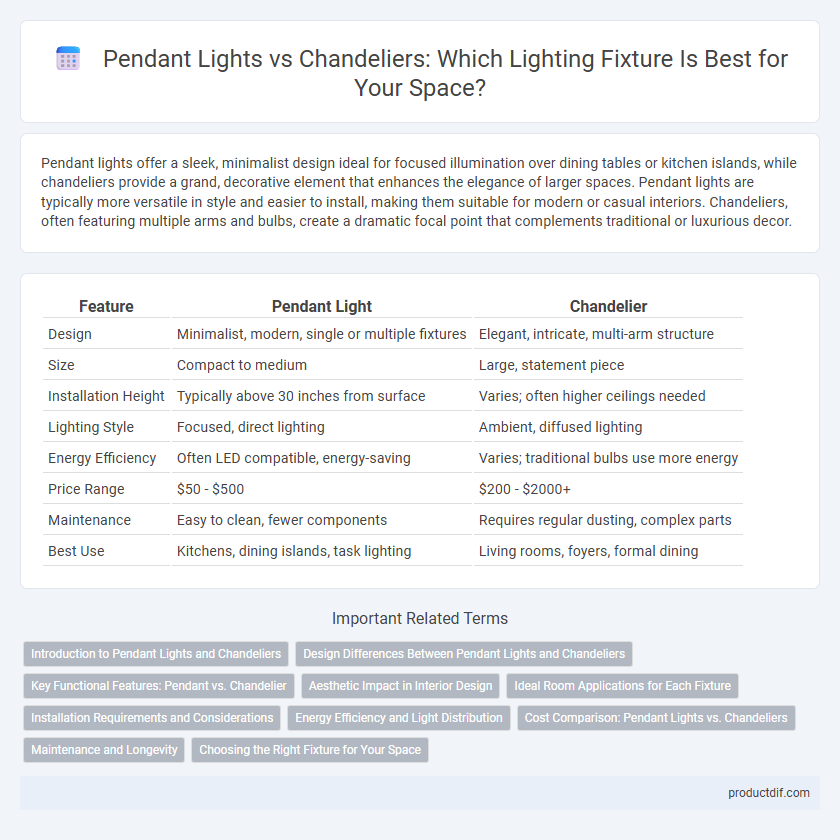Pendant lights offer a sleek, minimalist design ideal for focused illumination over dining tables or kitchen islands, while chandeliers provide a grand, decorative element that enhances the elegance of larger spaces. Pendant lights are typically more versatile in style and easier to install, making them suitable for modern or casual interiors. Chandeliers, often featuring multiple arms and bulbs, create a dramatic focal point that complements traditional or luxurious decor.
Table of Comparison
| Feature | Pendant Light | Chandelier |
|---|---|---|
| Design | Minimalist, modern, single or multiple fixtures | Elegant, intricate, multi-arm structure |
| Size | Compact to medium | Large, statement piece |
| Installation Height | Typically above 30 inches from surface | Varies; often higher ceilings needed |
| Lighting Style | Focused, direct lighting | Ambient, diffused lighting |
| Energy Efficiency | Often LED compatible, energy-saving | Varies; traditional bulbs use more energy |
| Price Range | $50 - $500 | $200 - $2000+ |
| Maintenance | Easy to clean, fewer components | Requires regular dusting, complex parts |
| Best Use | Kitchens, dining islands, task lighting | Living rooms, foyers, formal dining |
Introduction to Pendant Lights and Chandeliers
Pendant lights offer focused illumination with sleek designs, ideal for task lighting above kitchen islands or dining tables, featuring a single hanging fixture suspended by a cord, chain, or rod. Chandeliers provide a grand, decorative centerpiece with multiple light sources arranged on branched arms, often incorporating crystals or intricate metalwork for ambient lighting in formal spaces like dining rooms or foyers. Both lighting fixtures vary in style, scale, and light output, catering to diverse interior design needs and spatial functions.
Design Differences Between Pendant Lights and Chandeliers
Pendant lights feature a minimalist design with a single light source hanging from a cord, chain, or rod, offering focused illumination ideal for task or accent lighting. Chandeliers present a more elaborate and decorative structure, often incorporating multiple arms and bulbs, creating a grand centerpiece that provides ambient lighting with intricate details. The design differences highlight pendant lights as versatile and modern fixtures, while chandeliers serve as ornate elements that enhance traditional and luxurious interiors.
Key Functional Features: Pendant vs. Chandelier
Pendant lights provide focused, directional illumination ideal for task lighting over kitchen islands or dining tables, featuring adjustable cords or rods for customizable height. Chandeliers offer ambient, decorative lighting that enhances room aesthetics with multiple bulbs and elaborate designs suitable for large spaces. Both fixtures vary in light intensity, energy efficiency, and installation complexity, influencing their functional application in residential or commercial interiors.
Aesthetic Impact in Interior Design
Pendant lights create a focused, modern aesthetic with sleek designs that enhance minimalistic and contemporary interiors by providing targeted illumination and visual interest. Chandeliers offer a grand, luxurious aesthetic impact with intricate detailing and multi-arm structures, serving as statement pieces that elevate traditional or opulent interior styles. Choosing between pendant lights and chandeliers depends on the desired ambiance, scale of the space, and focal point emphasis within interior design.
Ideal Room Applications for Each Fixture
Pendant lights are perfect for task lighting over kitchen islands, dining areas, or entryways, providing focused illumination with a sleek, modern aesthetic. Chandeliers work best in larger spaces like living rooms, foyers, or formal dining rooms, offering ambient light and a dramatic focal point. Choosing between these fixtures depends on the room size, ceiling height, and desired lighting effect for functionality and style.
Installation Requirements and Considerations
Pendant lights typically require a single ceiling electrical box and straightforward wiring, making installation faster and less complex. Chandeliers often demand reinforced ceiling support due to their heavier weight and may need multiple electrical connections for various bulbs. Proper assessment of ceiling structure and electrical capacity is essential for both fixtures to ensure safety and functionality.
Energy Efficiency and Light Distribution
Pendant lights typically offer superior energy efficiency due to their focused illumination reducing wasted light and often accommodating LED bulbs with lower wattage. Chandeliers, while providing expansive and decorative light distribution, can consume more power as multiple bulbs are used to achieve even brightness across larger spaces. Selecting energy-efficient LED bulbs and dimmable features in both fixtures enhances overall energy savings and customizable light control.
Cost Comparison: Pendant Lights vs. Chandeliers
Pendant lights generally offer a more affordable lighting option compared to chandeliers, with prices often ranging from $50 to $300 depending on design and materials. Chandeliers tend to be more expensive, typically costing between $200 and $2,000 or more due to their complex structure and decorative elements. Installation costs also vary, with chandeliers requiring professional mounting and potentially higher electrician fees, while pendant lights are usually simpler and less costly to install.
Maintenance and Longevity
Pendant lights typically require less maintenance due to their simpler design and fewer bulbs, making bulb replacement and cleaning easier. Chandeliers, often more intricate with multiple arms and bulbs, demand regular dusting and occasional rewiring to maintain their functionality and aesthetic appeal. The longevity of pendant lights tends to be higher in modern, LED-based designs, while traditional chandeliers may last decades when properly maintained but can incur higher upkeep costs.
Choosing the Right Fixture for Your Space
Pendant lights offer focused illumination ideal for task areas like kitchen islands or reading nooks, while chandeliers provide ambient lighting and act as statement pieces in dining rooms or entryways. Consider ceiling height, room size, and desired light coverage to determine which fixture complements the space without overpowering it. Opt for adjustable pendants in smaller rooms for flexibility, or select a chandelier with multiple bulbs for expansive areas requiring more diffused light.
Pendant light vs Chandelier Infographic

 productdif.com
productdif.com